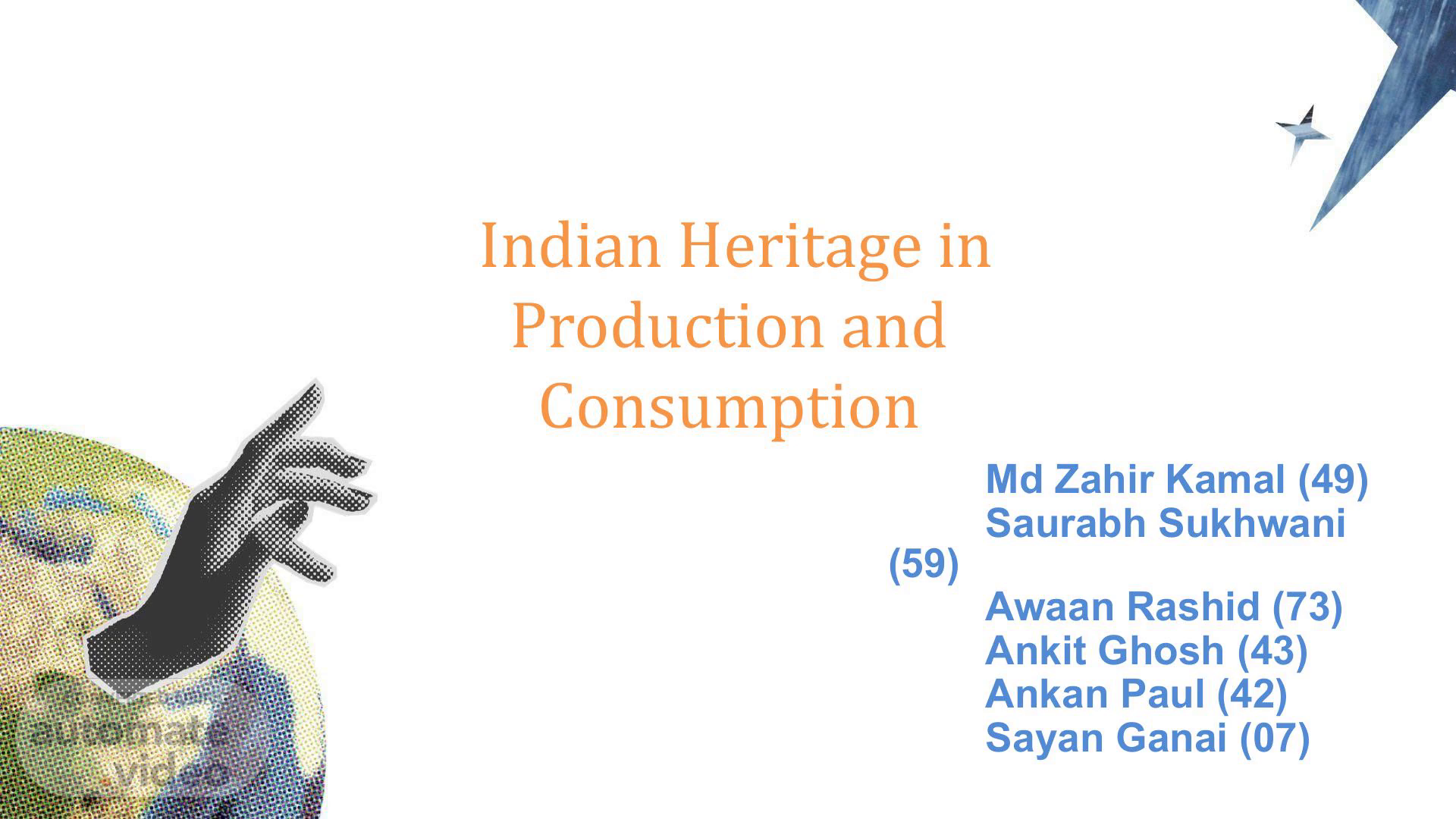
Page 1 (0s)
Indian Heritage in Production and Consumption Md Zahir Kamal (49) Saurabh Sukhwani (59) Awaan Rashid (73) Ankit Ghosh (43) Ankan Paul (42) Sayan Ganai (07).
Page 2 (9s)
Contents 1. Introduction 2. Historical Heritage of India 3. Indian Heritage in Production 4. Indian Heritage in Consumption 5. India's Influence on Global Stage 5. Challenges and Changes in Indian Production 7. Conclusion 8. Thank You.
Page 3 (21s)
Introduction India's heritage is deeply rooted in its historical mosaic, weaving together the threads of ancient civilizations, mighty empires, and profound philosophical thought. The remnants of the Indus Valley Civilization, one of the world's oldest urban centers, bear witness to the advanced urban planning and artistic achievements of ancient India. The rise and fall of empires like the Mauryas, Guptas, and Mughals have left an indelible mark on the nation's heritage, shaping its architecture, literature, and cultural practices. India, the land of ancient wisdom and timeless traditions, boasts a heritage as diverse and vibrant as the myriad colors of its landscapes. Encompassing a rich tapestry of history, culture, art, and spirituality, Indian heritage stands as a testament to the country's glorious past and its continuous evolution through centuries. From the enchanting melodies of classical music echoing through ancient temples to the intricate carvings adorning majestic palaces, Indian heritage is a celebration of the human spirit, creativity, and resilience..
Page 4 (1m 2s)
Historical Heritage of India Ancient Indian Civilization to Independence India's heritage dates back to ancient civilizations, such as the Indus Valley Civilization, showcasing advanced urban planning and artistic achievements. 1 Ancient Civilizations The rise and fall of empires like the Mauryas, Guptas, and Mughals have left an indelible mark on India's heritage, shaping its architecture, literature, and cultural practices. 2 Empires and Cultural Infiuence After gaining independence in 1547, India adopted a mixed economy model with elements of socialism, marking a pivotal moment in the country's economic history. 3 Post-Independence The First Five-Year Plan (1551-1555) marked the beginning of planned economic development, focusing on key sectors like agriculture, industry, and social welfare. 4 First Five-Year Plan.
Page 5 (1m 32s)
Indian Heritage in Production Testament to Rich Cultural and Artistic Traditions Ancient Craftsmanship India has a long history of craftsmanship dating back to ancient civilizations, with artifacts showcasing advanced metallurgical and pottery techniques. Textile Tradition India is renowned for its rich textile heritage, with regions like Varanasi, Banaras, and Kanchipuram being famous for their silk production..
Page 6 (1m 49s)
Indian Heritage in Consumption Diverse Tapestry of Traditions, Rituals, and Practices Culinary Diversity 1 India is known for its incredibly diverse and flavorful cuisine, with regional specialties and cooking techniques varying widely across the country. 2 Traditional Clothing and Textiles The choice of clothing in India is deeply rooted in heritage, with various regions having their distinctive styles. 3 Festivals and Celebrations Indian heritage is marked by a multitude of festivals like Diwali, Holi, Eid, and Christmas, each contributing to the rich tapestry of cultural consumption..
Page 7 (2m 12s)
India's Influence on Global Stage India's heritage in production and consumption has made a significant impact on the global stage, from the intricate carvings on ancient temples to the vibrant culinary diversity, showcasing the country's exceptional skill and creativity. Furthermore, India's contributions to software development and information technology demonstrate the country's ability to adapt, innovate, and compete internationally. The cultural heritage of India encompasses various aspects such as literature, art, music, dance, architecture, food, and religions, which have been shaped and nurtured over thousands of years. India, with its extensive cultural legacy, has made great efforts to use technology to preserve and promote its rich traditions and artefacts..
Page 8 (2m 42s)
Challenges and Changes in Indian Production Factors Influencing Production and Consumption Patterns India has faced challenges and changes in its production and consumption patterns due to various factors such as colonialism, globalization, and urbanization. Historical Infiuences 1 2 Resurgence of Interest There's a resurgence of interest and awareness in India's heritage and culture among the people, especially the younger generation, leading to efforts to preserve, promote, and revitalize traditional forms of production and consumption..
Page 9 (3m 3s)
Conclusion In conclusion, Indian heritage in production and consumption is a testament to the country's remarkable cultural legacy, spanning millennia of craftsmanship, artistic expression, and traditional practices. The intricate carvings on ancient temples, the exquisite textiles, and the craftsmanship in metals and pottery stand as enduring examples of India's exceptional skill and creativity in production. In summary, Indian heritage in production and consumption is a living tapestry woven from the threads of tradition, innovation, and cultural continuity. It is a source of pride, a reflection of diversity, and a testament to the enduring influence of India's cultural heritage on the global stage. It is a legacy that continues to shape the country's identity, connecting its past with a dynamic and ever-evolving present..
Page 10 (3m 35s)
Thank You.